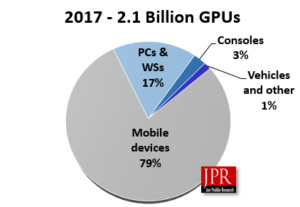Jon Peddie Research (JPR) has just released in annual review of GPU developments for 2017. The report is available free to subscribers to Jon Peddie’s TechWatch, or costs $100 to others.
In spite of the overall slow decline of the PC market, PC-based GPUs sales, which include workstations, have been increasing. In the mobile market, integrated GPUs have risen at the same rate as mobile devices and the SoC in them. The same is true for the console market where integrated graphics are in every console and they too have increased in sales over the year.
Figure 1: Mobiles devices use more GPUs than all other platforms combined.
JPR didn’t count the GPUs used in the data center since they don’t drive a display (so the “G” in data-center GPUs is irrelevant). Even if the firm had included them they would not have made any noticeable difference to the numbers, it said.
Nearly 28% of the world’s population bought a GPU device in 2017, and that’s in addition to the systems already in use. And yet, probably less than half of them even know the term GPU, what it stands for, or what it does. To them the technology is invisible, and that means it’s working – they don’t have to know about it.
The market for, and use of, GPUs stretches from supercomputers and medical instrumentation to gaming machines, mobile devices, automobiles, and wearables. Just about everyone in the industrialized world has at least a half dozen GPUs, and technophiles can easily count a dozen or more.
The manufacturing of GPUs approaches science fiction with features that will move below 10 nm next year and have a glide-path to 3 nm, and some think even 1 nm-Moore’s law is far from dead, but is getting trickier to tease out of the Genie’s bottle as we drive into subatomic realms that can only be modeled and not seen.
2017 was an amazing year for GPU development, JPR said, driven by games, eSports, AI, crypto currency mining, and simulations. Autonomous vehicles started to become a reality, as did augmented reality. The over hyped consumer-based PC VR market explosion didn’t happen, and had little to no impact on GPU developments or sales. Most of the participants in VR already had a high-end system and the HMD was just another display to them.
Mobile GPUs, exemplified by Qualcomm, ARM, and Imagination Technologies’ customers introduced some amazing devices with long battery life, screens at or approaching 4K, and in 2017 we started talking about and showing HDR.
The calendar is an artificial event marker and the developments in GPUs doesn’t pause for holidays, or annual clock ticks. Many, if not all, the developments we will see in 2018 were started as early as 2015, and that three to four-year lead time will continue, and may even get longer as we learn how to deal with chips constructed with billions of transistor manufactured at feature sizes smaller than X-rays.
2018 is going to be an even more amazing year, with AI being the leading applications that will permeate every sector of our lives, the company concluded.
Analyst Comment
Some years ago, when we had teenagers at home and a home office, we went around our house (and cars) and counted CD mechanisms – we found more than 20, many more than any of us thought. The same is true of GPUs. In the article that we linked to by EE Times, there is a very good graphic that shows the strong positition that Nvidia has developed in the automotive industry. (Nice Article on Autonomous Vehicles). (BR)

